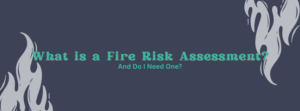FIRE RISK ASSESSMENTS
First introduced in 2006, as part of the Regulatory Reform (Fire Safety) Order 2005, Fire Risk Assessments are an important and legal requirement for any premise where there are people working or visiting, to ensure the safety and wellbeing of all.
SHOULD I GET A FIRE RISK ASSESSMENT?
There are some businesses that GOV.UK specifically recommends undertaking a Fire Risk Assessment, such as offices, hospitals, places of worship, pubs and theatres, however the short answer is… Yes! Not only is it a legal requirement, but a Fire Risk Assessment can save lives and keep your business safe, no matter the size or risk level of your building. We recommend that all businesses carry out a Fire Risk Assessment on a regular basis to ensure that everyone is safe and you’re ready with a plan in place if something should go wrong.
_________________________________________________________________________________
There are five key steps in a Fire Risk Assessment that our engineers follow:
STEP ONE: Identify Fire Hazards
A fire hazard is any source of ignition of combustible material such as kitchen equipment, clothing, electrical equipment, arson and heating. This also includes sources of oxygen such as air conditioning that could be more vulnerable to fire as there is a clear airflow that could help fire spread quicker.
Each source of fire behaves different and may need a different type of fire extinguisher to combat it. A competent Risk Assessor will identify the potential source of a fire and be able to best advice on what type of fire extinguisher or suppression system should be used in each room.
STEP TWO: Identify People Who Are at Risk
It is important to know who you expect to be on the premises should a fire occur and what their individual requirements are. For example, someone carrying a child, a child themselves or persons with limited mobility, those who work in an isolated area or may have difficulties understanding English, may need more help or a different exit route to keep them safe compared to other employees or visitors. It is crucial to consider this when creating an effective plan of action to take within an emergency.
Knowing the number of employees within the building can also help you to preform a headcount upon evacuation to identify anyone that may be trapped in the building or missing.
STEP THREE: Evaluate and Act
How many floors are in the building? Are all emergency exits properly sign posted and visible? Are any fire extinguishers, alarms, signage and lighting needed? Is the emergency lighting, sprinkler systems and alarms working correctly?
We recommend that these measures are checked throughout the year, to ensure that all safety measures are up to date, working effectively and, in the case of fire extinguishers, not expired. If there are any issues with extinguishers, signage etc, it is important to get them fixed or installed immediately or a business could find itself not only responsible for loss of life but also subject to legal action should anything occur.
Any items that could block access to fire exits or essential equipment should also be removed immediately. Flammable materials that are near sources of heat or ignition should also be relocated to a safe area within the premise of the company or building.
Once the risks are identified and evaluated, care should be taken to follow the guidance of the Risk Assessor from that moment forward, to keep everyone safe.
STEP FOUR: Record, Prepare, Plan and Train
Once a Fire Risk Assessment has been completed, it is important that the findings are well documented. A business should have a record of the report and keep it safe, so that employees can access it when needed and any further inspections can refer to the previous assessment.
An emergency plan should be created that is then relayed to all employees, so that they know what to do in the event of a fire. This can be implemented alongside with clear emergency exit signs, emergency lighting and accessible fire alarms and extinguishers. Visitors to the building should also be informed and be able to clearly see where the fire exits are, and where to go. Emergency signage should also include any designated Fire Meeting points, to allow for an easy head count to occur.
Training is important for any employees to undertake. They should be aware of what to do in the event of a fire, and this includes committing to carrying out regular fire drills and sending out important information when changes are made to the plan of action. We also recommend implementing a Fire Marshall who will stay calm and help guide others in the event of a fire (we offer training specifically for Fire Marshalls!)
STEP FIVE: Review and Update
Although the Fire Risk Assessment may only take place once a year, it is important that the individuals responsible for safety within a company continue to review, update and make changes to the emergency plan throughout the year.
If you experience a fire or make any significant or structural changes to your building, you should have a new Fire Risk Assessment carried out as soon as possible. This can also include changes to the function of a part of the building or hiring someone with accessibility needs where a new plan should be put in place to keep everyone safe.
Employees should still be reminded regularly about the plans in place and equipment should be maintained and checked throughout the year to avoid any risks or potential safety failures. If an employee notices an issue, such as a damaged fire extinguisher, faulty lighting, incorrect signage or failure in alarm system, which would be identified through regular fire drills, it should be reported and rectified immediately.
If there are no changes or issues throughout the year, then a Fire Risk Assessment should be carried out the following year. Failure to do so could result in insurance issues or legal action.

